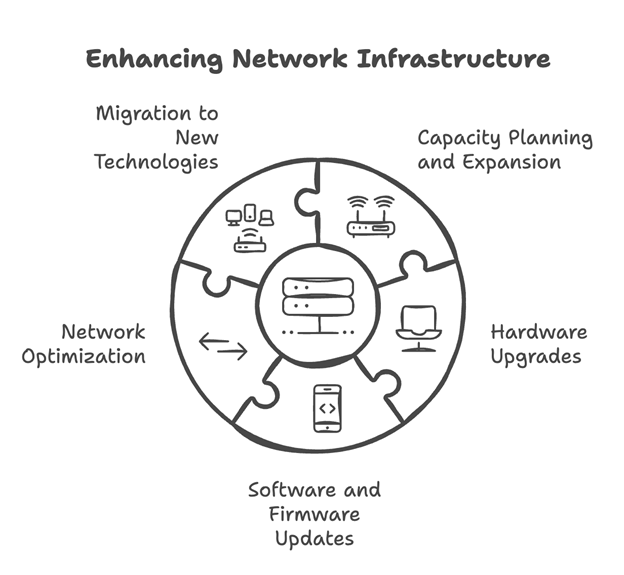Telecommunication networks are complex systems that require regular updates to stay efficient, scalable, and secure. Network modification focuses on enhancing various aspects of these systems. Below are the key components of network modification that play a pivotal role in achieving operational excellence.
Network modification is not just about upgrading infrastructure; it’s a strategic approach to future-proofing telecom systems. With the rapid evolution of technologies like 5G, IoT, and edge computing, adapting networks to these advancements ensures operational excellence, cost efficiency, and enhanced user experiences. Understanding the essential components of network modification enables telecom providers to meet increasing demands while maintaining competitive advantages. Network modification focuses on enhancing various aspects of these systems. Below are the key components of network modification that play a pivotal role in achieving operational excellence.

Capacity planning ensures that a network can handle current and future demands without compromising performance. Expansion involves increasing bandwidth, storage, or processing capabilities to meet growing user needs.
A regional telecom provider forecasts a 30% increase in traffic over the next year and adds additional servers and bandwidth to maintain seamless service.
Use tools like SolarWinds or Nagios to monitor and forecast network traffic, ensuring proactive capacity planning.

Hardware upgrades involve replacing outdated equipment such as routers, switches, and servers with modern counterparts. This improves network performance and energy efficiency.
Replacing legacy switches with high-capacity, cloud-compatible hardware reduces latency and prepares the network for future demands.
Modern routers can increase data transmission speeds by up to 50% while reducing energy usage by 30%, making them a cost-effective upgrade.

Software updates and firmware enhancements are essential for maintaining network security and compatibility. Regular updates address bugs, improve features, and ensure the network operates smoothly.
Automated firmware updates allow a telecom provider to patch security flaws without manual intervention, reducing downtime.
Schedule updates during off-peak hours to minimize disruptions and ensure seamless transitions.

Network optimization focuses on improving the efficiency and reliability of data transmission. This involves reconfiguring network architecture, balancing traffic loads, and eliminating bottlenecks.
A large enterprise optimizes its network to support video conferencing by reallocating bandwidth during peak hours.
Studies show that optimized networks can improve data transmission efficiency by up to 35%, reducing operational costs significantly.

Migrating to new technologies, such as 5G or cloud-based systems, involves replacing outdated solutions with modern, efficient alternatives. This ensures the network remains competitive and capable of supporting cutting-edge applications.
A telecom company transitions from 4G to 5G infrastructure to meet increasing demand for high-speed connectivity and low-latency applications.
5G networks can achieve speeds up to 100 times faster than 4G, making them a game-changer for industries like healthcare and gaming.

Each key component of network modification—from capacity planning to technology migration—is a vital piece of a cohesive strategy designed to optimize telecom infrastructure. These components work in unison to create networks that are not only efficient and scalable but also resilient against future challenges.
Investing in these modifications empowers telecom providers to adapt to emerging demands, reduce operational complexities, and deliver superior user experiences. By implementing these strategies, providers position themselves as leaders in an increasingly competitive and connected world.
Explore detailed strategies and insights on network modification in our Comprehensive Guide to Network Modification.